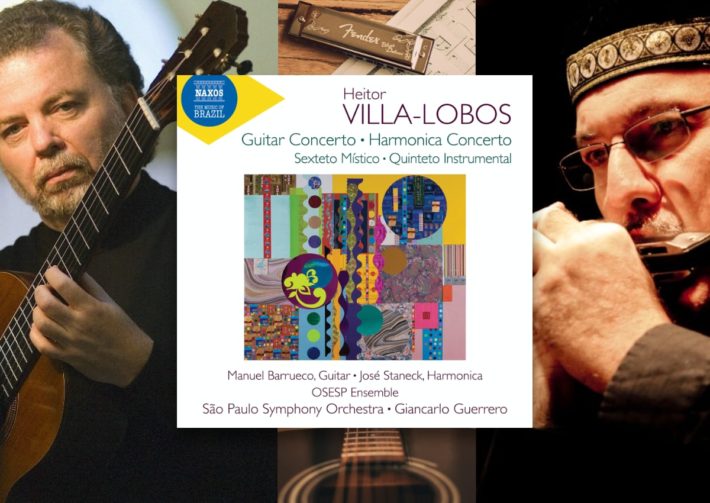Naxos releases a new album of concerti and chamber works of Brazilian composer Heitor Villa Lobos (1887-1959). His compositions reflect a unique style characterized by conflict and eventual amalgamation of two opposing influences: the Western Classical tradition and the folk music and native legends of his Brazilian heritage.
Sexteto Místico (1917) reflects Villa Lobos’ early chamber music style and his experimentation with creative instrumentation (flute, oboe, harp, saxophone, guitar, celesta). There is an interesting grouping between the woodwinds (often placed together in consonant harmonies) and string instruments: this speaks to the mystical nature of the work, creating a dialogue of intriguing sonorities further heightened by the use of dissonance and polytonality (1’02-1’15). The ensemble playing is well-balanced: though the woodwinds hold the melodic line for a good portion of the time, the delicacy of the harp is not over masked, the warmth of the guitar comes through, and the harp adds an ethereal layer. The woodwinds too give a strong performance: an example is 6’54”-7’12”, where the articulation is impeccably coordinated.
The Guitar Concerto (1951) shows the style of a mature composer who has reconciled his Brazilian influences with the classical idiom. The guitar possesses both a virtuosic and lyrical character, both of which soloist Manuel Barrueco shows well. In the first movement, he has clarity of sound which gives way to beautiful phrasing (try 2’54”). This lyrical section displays the complexity of Villa-Lobos’ guitar writing, with its different concurrent melodic lines. Barrueco has good voice leading that intertwines these lines smoothly. In the second movement, he creates a delicate balance between melody and accompaniment, using the richer lower timbres of the guitar to give his playing richness and shape, while creating a singing line in the plaintive upper register (0’41”). The orchestra shines in the third movement: its interludes are full of energy that complements the guitar’s virtuosic line. However, some moments could use a little better communication and balance between soloist and orchestra as in 2’11”, where the wind line needs more prominence to support the dialogue.
There are just a handful of composers (including Darius Milhaud, Ralph Vaughan Williams, and Henry Cowell) who wrote classical works for harmonica. Villa-Lobos’ Harmonica Concerto, Op. 86, transforms this handheld instrument into a large presence. Composed four years after the Guitar Concerto, it reflects the composer’s more tonally experimental and developed style. Just as the Guitar Concerto highlights the instrument’s virtuosity and expressiveness, the Harmonica Concerto brings to the forefront the harmonica’s melodic range and coloristic capabilities. The second movement is impressive, placing both the soloist and orchestra against a coloristic backdrop of rich, unexpected harmonies. The orchestral introduction gives the movement a beautiful and expansive entrance. Soloist José Staneck continues this with good use of color changes over an expressive line (0’30 onward). There are quite a few moments where the harmonica plays in a very high register. The nature of its timbres can lend itself naturally to sounding pitchy or scratchy, but Staneck shows good sound control; upper tones always sing. One major issue, however, in this concerto is the balance between soloist and orchestra, which could be much better. The intent, it seems, was to prevent the harmonica from being masked by the volume of the orchestra. However, the latter sounds often subdued throughout and doesn’t give the harmonica enough support when necessary. The imbalance also makes the harmonica overpower the orchestra at times. At 2:40 in the first movement, a lyric section begins where the melody is played beautifully by the oboe. When this line is handed off to the clarinet, the harmonica comes in with accompaniment material which is so prominent that the clarinet can barely be heard. It is a shame, since it is these delicate moments that should lend the piece a magical quality.
Quinteto instrumental, written two years before Villa Lobos’ death, is perhaps the most eclectic and harmonically adventurous of the works presented. There is an overarching theme of a juxtaposition of parallel consonant harmonies and dissonance (i.e. 0’57-1’30). The ensemble sound is generally well integrated, but the second movement is a bit wanting in this aspect: the harp sets up a delicate opening which the flute can better coordinate stylistically and dynamically. The ensemble, however, does capture the vibrant and sprightly nature of the third movement particularly well.
The liner notes are well-written and informative for the curious listener, giving not just a compositional background for all the presented works, but also insightful historical context.

Villa Lobos – Guitar Concerto, Harmonica Concerto, Sexteto Místico, Quinteto Instrumental
Manuel Barrueco – Guitar
José Staneck – Harmonica
São Paulo Symphony Orchestra
Giancarlo Guerrero – Conductor
Naxos, CD 747313401871
Villa Lobos Guitar and Harmonica Concertos – Recommended Comparisons
Read more classical music reviews or visit The Classic Review Amazon store
Follow Us and Comment:
Get our periodic classical music newsletter with our recent reviews, news and beginners guides.
We respect your privacy.









